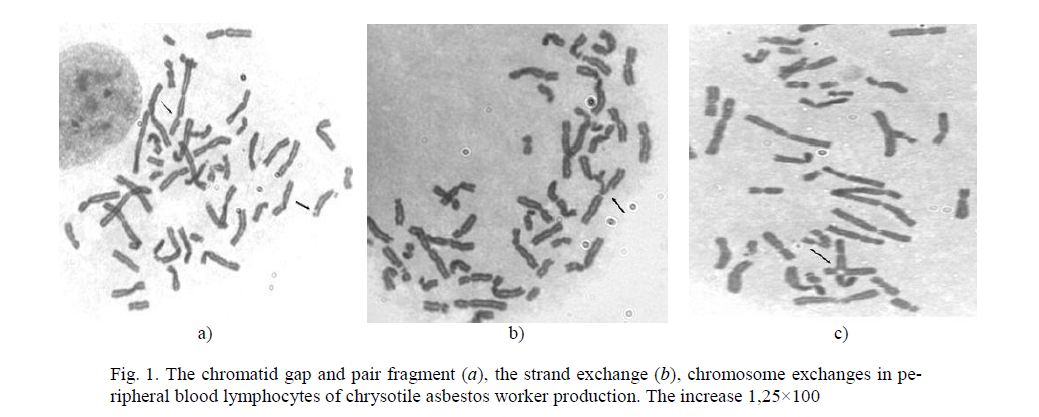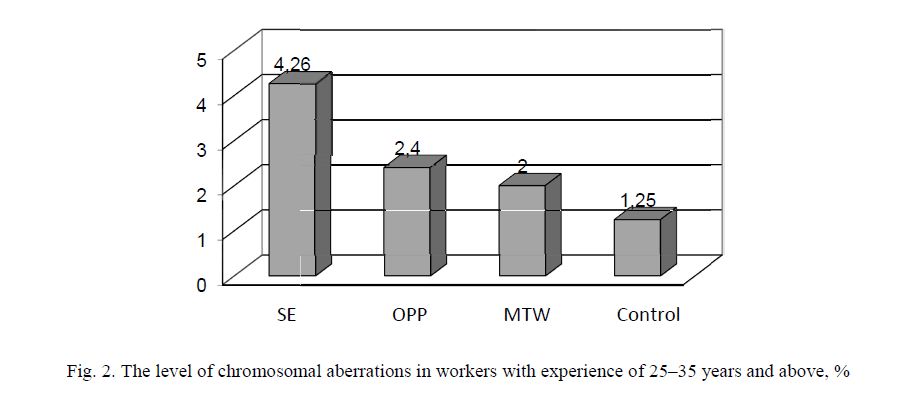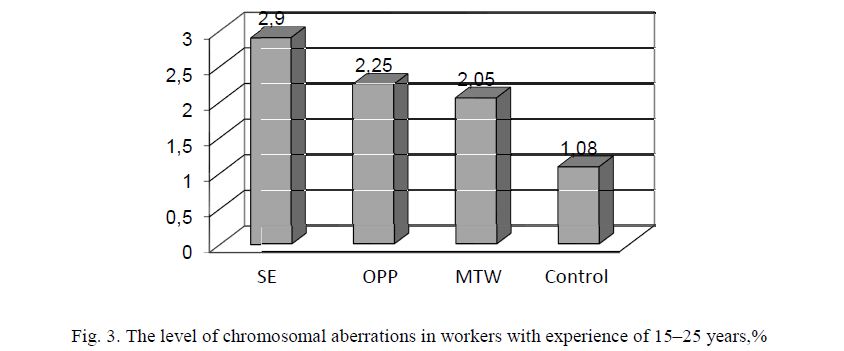Actuality. To date, assessment of the effects of the mutagen-induced production factors and the effects of environmental factors is carried out by detecting chromosomal damage by analysis of chromosomal aberrations and sister chromatid exchanges in peripheral blood lymphocytes. To evaluate the mutational event is necessary to use method of accounting for chromosomal aberrations, which is a highly sensitive methods of biological indication of human exposure to mutagens and production of environmental factors. In the molecules of DNA genetic information is encoded, mutagenic, acting on the cell, leading to breaks and rearrangements of chromosome structure [1]. In the formation of chromosomal aberrations important stage of the mitotic cell cycle, which occurred at the time of the impact of the mutagen.
Damage to the genetic apparatus of cells forms the basis of violations of biological reactions. According to N.P.Bochkov and A.N.Chebotarev, chromosomal aberrations are an early indicator of adverse effects on the body before they will develop pathological processes. In some countries, accounting cytogenetic analysis of chromosomal aberrations is used as a control method of mutagens and raises the question of restricting professionals on genetic grounds. As a result of works by American authors found that the mutagenic effects at low doses is important in assessing the carcinogenicity of substances has been investigated with 134 substances listed in the National Toxicology Program USA [2–5]. Studies on the structural variation of chromosomes in lymphocytes, provides an opportunity not only quantitative, but also qualitative account the need for objectivity and accuracy of test results. Studies of the spontaneous level of chromosomal aberrations in human peripheral blood lymphocytes in the last 30 years have shown that the level of chromosomal aberrations increased by 1.5–2 times to the present time, 1.56–2.78 % [5, 6].
A team of researchers found mutagenic activity of heavy metal salts, which contacted the workers of cobalt and tungsten in the production of plants at steel mills, manifested a significant increase in the level of chromosomal aberrations in lymphocytes of the workers at these plants compared with the control group by 2.5–3 times [7].
According to some authors, the workers of lead refineries traced the growth of disease, based on considerable importance is the accumulation of adverse genetic load. The frequency of chromosomal aberrations in workers of lead production exceeds spontaneous level [8], other researchers have noted that the metal ions possess mutagenic activity due to destruction or binding of natural antimutagens cells [9].
At the present time particularly relevant in the diagnosis of prenosological is to study the role of individual human sensitivity to adverse environmental factors. Polymorphism of enzymes responsible for metabolism of mutagens, determines the ability of an organism to mutations [10–12].
Thus, all of the above confirms that the study of the chemical nature of mutagens, scientists are paying great attention, which confirms the need to further examine the state of the genetic status of persons employed in manufacturing. Analysis of the literature has shown promising use of micronucleus test and the method of accounting for chromosomal aberrations in peripheral blood lymphocytes to detect cytogenetic damage from exposure to factors of production.
The aim of investigation: to study the cytogenetic status of the workers of chrysotile asbestos production by method of accounting of chromosomal aberrations in peripheral blood.
Materials and methods. A retrospective cohort study of workers of main shops of JSC «Kostanai minerals is carried out.» In order to study the cytogenetic status of the accounting method of chromosomal aberrations in peripheral blood of 50 men studied male, working on chrysotile asbestos production: 20 out of the shop enrichment (SE) and 15 of the ore preparation plant (OPP) and mining-transport workshop (MTW). In the SE (group 1) — the average age was examined 47,8 ± 1,3 years, the average length — 27,4 ± 0,82 years. In group 2 (OPP) — the average age of workers was 48,2 ± 1,05 years, the average length of service — 23,2 ± 0,65 years. In group 3 (MTW) — the average age of surveyed — 45,1 ± 0,93 years, average length — 25,0 ± 0,06 years. The control group consisted of 12 male workers in non-manufacturing sector, whose average age was 42,8 ± 2,01 years, the average length of service — 24,8 ± 0,96 years (Table 1).
Number of persons examined for chromosomal aberrations account for the group, depending on length of service
T a b l e 1

Each of the surveyed groups was divided into two subgroups depending on the length from 15 to 25 years and 25 to 35 years and above. All respondents at the time of blood sampling did not take chemotherapy and hormone therapy, and were not subjected to X-ray examination the past 3 months.
Statistical analysis was carried out with material of PP «STATISTICA 5.5», with the calculation of average performance (M ± m), t — the Student for comparisons between groups.
To account for the frequency and types of chromosome aberrations in human peripheral blood lymphocytes using a modified method of cultivation of peripheral blood lymphocytes of Hungerford DA et al. [13]. Consideration of chromosomal aberrations was performed using a microscope «NiKon Eclips 400» (Japan, 2005) and the system of karyotypes LUCIA Cytogenetics KARYO. Criteria for selection of metaphases corresponded to the generally accepted guidelines (N.P.Bochkov, 1989) [1]. From each individual were analyzed in 200 metaphases. All the results of cytogenetic analysis of the aberrations introduced into the uniform modeled on protocols approved by the Local Ethics Committee (Protocol № 4 of 16.05.2008)
Results and discussion. The results of cytogenetic studies by taking into account the status of chromosome aberrations (Table 2) demonstrated in peripheral blood lymphocytes of workers of major groups of chrysotile asbestos production significantly increased frequency of chromosome aberrations by 2.4 times (2,87 ± 0,16 %) compared with those of the individuals the control group (1,16 ± 0,21 %).
At the same time structural changes of chromosomes in the study group presented chromosome aberrations and chromatid types (Fig. 1).
The frequency of chromosome type aberrations in the exposed group was 1,19 ± 0,10 %, chromatid — 1,68 ± 0,12 %. In the control group, respectively — 0,58 ± 0,15 % and 0,58 ± 0,15 %, the difference is reliable indicators at p <0.01. Aberrations of chromosome type were 41.5 % of the total chromosomal abnormalities in the major groups and, respectively, 58.5 % were chromatid-type. This ratio of types of chromosomal aberrations speaks in favor of chemical mutagenesis [5–7].
When analyzing the frequency and types of chromosomal aberrations in the examined individuals, depending on the place of work (shop) and work experience revealed that the highest level of chromosomal aberrations was observed in the second group of plant concentration and it reached 4,26 ± 0,36 %, which compared with the control group is 3.4 times higher (p <0.01) (Fig. 2).
T a b l e 2
The frequency and types of chromosomal aberrations (CA) in patients and control group (M ± m)


Fig. 1. The chromatid gap and pair fragment (a), the strand exchange (b), chromosome exchanges in peripheral blood lymphocytes of chrysotile asbestos worker production. The increase 1,25×100

Fig. 2. The level of chromosomal aberrations in workers with experience of 25–35 years and above, %
This group belonged to a group of people with experience of 25–35 years and above. Considering the group in a given period of probation may be noted as an increased level of chromosomal aberrations induced in the shop ore preparation (group 4) but not in such large numbers as in the enrichment of the shop — 2,40 ± 0,48 %, which exceeded the benchmark by 1.9 times (p < 0.05). In the mining-transport workshop marked the lowest level of chromosomal aberrations compared with the previous two major groups — the SE and OPP. This figure was established at the level of 2,0 ± 0,40 %, which exceeds the reference level of 1.6.
Considering the frequency of chromosomal aberrations in the groups surveyed, those with experience of 15–25 years, it may be noted that the highest level observed in the SE (Group 1) — 2,9 ± 0,53 %, that compared with the control group higher in the 2 6-fold (p <0.01).
The shop ore dressing (group 3), this figure was established at the level of 2,25 ± 0,33 %, which is also higher than the control level in 2-fold (p <0.05). In the fifth group — the MTW, the level of chromosomal aberrations is 2,05 ± 1,33 %, which is also higher than the value of the control group in the probation period by 1.9 times (Fig. 3).

Fig. 3. The level of chromosomal aberrations in workers with experience of 15–25 years,%
Analyzing the types of chromosomal aberrations may be noted that the failure of the chromosomes are of two types: chromosome and chromatid. Breakage of the chromosome type are paired fragments and discontinuities of the centromere, chromatid-type — deletions, fragments and single chromatid breaks. Paired fragments in the main groups were 33.1 % (95 cases) of the total chromosome type aberrations, and the remaining 8.4 % (24 cases) belonged to the rupture of the centromere. In the control group chromosome type breakage are also paired fragments (9 cases), which accounted for 32.1 % of the total number of chromosomal aberrations in the control group and the discontinuities of the centromere — 5 cases (17.8 %).
Chromatid type aberrations in the main groups were as follows: deletion of 11.9 % (20 cases), single pieces — 21.4 % (36 cases) and chromatid breaks — 56.5 % (112 cases), breaks — 9 cases (32.1 %). In the control group are broken chromatid-type aberrations and similar types were as follows: deletion (1 case) — 3.6 %, single pieces — 4 cases (14.3 %).
Thus, the results of the studies showed that elevated levels of chromosomal aberrations in enriching chrysotile asbestos ore, have been observed among workers in the shop and the enrichment of the persons working in the shop of ore dressing. With higher rates are found among workers with experience of more than 25 years. In the mining-transport workshop performance level of chromosomal aberrations in workers slightly higher than in the control and almost fit into the framework of spontaneous mutagenesis. When comparing the trained groups of plant indicators of the frequency and types of chromosomal aberrations did not differ.
Conclusions. A significant increase in chromosomal aberrations in individuals working in the chrysotile asbestos industry, while structural changes of chromosomes were represented by chromatid aberrations and chromosome types, which may testify in favor of chemical mutagenesis.
Higher rates were observed in induced mutagenesis operating enrichment plant of chrysotile asbestos and in those with experience of over 25 years.
The results of cytogenetic studies have shown that the frequency of cells with chromosome aberrations in peripheral blood lymphocytes of the main group significantly exceeded targets by 2.4 times.
Aberrations of chromosome type constitute 41.5 % of the total number of chromosomal breakage in the main group and 58.5 %, respectively, constitute the failure of chromatid type.
Elevated levels of chromosomal aberrations in the production and enrichment of chrysotile asbestos ore occur in working in the shop enrichment. With higher rates are found among workers who have been working for over 25 years. Individuals working in the shop ore preparation also noted increased levels of chromosomal aberrations compared with the control group, and there is a direct relationship with the experience of work: higher rates (2.9 %) were detected at a higher work experience (over 25 years).
References
- Bochkov N.P., Tchebotaryov A.N. Heredity of the person and environment mutagens. — M.: Medicine, 1989. — 270
- Bochkov N.P. Ecological genetics of the person // Medicine of work and industrial ecology. — 2004. — № 1. — P. 1–6.
- Tchebotaryov N. Regularities of chromosomal variability of somatic cages of the person // The Messenger of the Russian Academy of Medical Science. — 2001. — № 10. — P. 64–69.
- Dotan Y., Lichtenberg D., Pinchuk I. Lipid peroxidation cannot be used as a universal criterion of oxidative stress // Prog Lipid — 2004. — № 43. — P. 200–227.
- Bochkov N.P., Tchebotaryov A.N. et al. A database for the analysis of quantitative characteristics of frequency of chromosomal aberrations in culture of lymphocytes of peripheral blood of the person // — 2001. — Vol. 37 — № 4. — P. 549–557.
- Druzhinin G., Minina V.I., Mokrushina N.V. Cytogenetic violations at workers of coke-chemical production // Medicine of work and industrial ecology. — 2000. — № 10. — P. 22–24.
- Bobyleva A., Chopikashvili E.Z. et al. Revealing of groups of the raised risk among the workers contacting to heavy metals, on the basis of the analysis of chromosomal aberrations and nursing chromatid exchanges // Cytology and genetics. — 1991. — Vol. 25. — № 3. — Р. 18–23.
- Shushkevich I. Cytogenetic instability at long impact of lead on an organism of workers of lead production // Medicine of work and industrial ecology. — 2007. — № 8. — P. 10–14.
- Koshkina V.S., Antipanova N.A., Kotljar N.N. Monitoring of prevalence of chemical carcinogens in objects of environment and biological environments at residents with the developed branch of ferrous metallurgy // Hygiene and sanitary. — 2006. — № — P. 12–13.
- Kulkybaev A., Bajmanova A.M. et al. Cytogenetic inspection of working coal mines and polymetallic mines // The medical magazine of Astana. — 2003. — № 4. — P. 36–39.
- Bajanova M.F., Kulkybaev G.K. et al. Cytogenetic instability at workers of titano-magnesium production depending on working conditions // Medicine of work and industrial ecology. — 2004. — № 11. — P. 16–20.
- Greim I.I., Borm P. et al. Toxicity of fibers and particles — report of the workshop held in Munich, Germany // Inhal — 2001. — Vol. 13. — № 9. — Р. 737–754.
- Hunderford A. Leukocytes cultured from small inoculate of whole blood and the preparation of metaphase chromosomes by treatment with hypotonic KCl // Stain Technology. — 1965. — Vol. 40. — № 6. — P. 333–338.